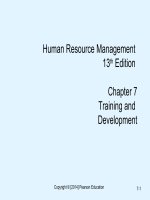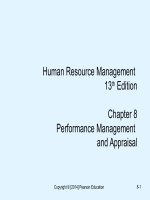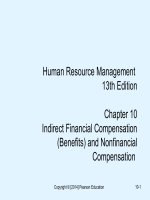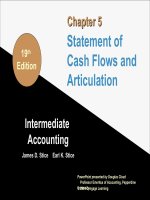Human resource 1e by denisi griffin chapter 05
Bạn đang xem bản rút gọn của tài liệu. Xem và tải ngay bản đầy đủ của tài liệu tại đây (826.86 KB, 27 trang )
©
© 2012
2012 South-Western,
South-Western, Cengage
Cengage Learning,
Learning, Inc.
Inc.
All
All rights
rights reserved.
reserved.
Prepared
Prepared by
by Joseph
Joseph B.
B. Mosca,
Mosca, Monmouth
Monmouth University
University and
and
Marla
Marla M.
M. Kameny,
Kameny, Baton
Baton Rouge
Rouge Community
Community College
College
PowerPoint
PowerPoint Presentation
Presentation Design
Design by
by Charlie
Charlie Cook
Cook
The
The University
University of
of West
West Alabama
Alabama
Learning Objectives
After studying this chapter, you should be able to:
1. Describe human resource planning as a source of
information for decision making.
2. Discuss strategy as a source of information for
making human resource decisions.
3. Discuss economic conditions as a source of
information for making human resource decisions.
4. Describe job analysis as a source of information for
making human resource decisions.
5. Discuss the job analysis process and Identify and
summarize common job analysis methods.
© 2012 South-Western, Cengage Learning, Inc. All rights reserved.
5–2
What Is Human Resource
Planning?
The process of forecasting the
supply and demand for human
resources within an organization
and developing action plans for
aligning the two.
© 2012 South-Western, Cengage Learning, Inc. All rights reserved.
5–3
The Human Resource Planning Process
© 2012 South-Western, Cengage Learning, Inc. All rights reserved.
5–4
Beyond the Book:
Planning Human Resource Programs
© 2012 South-Western, Cengage Learning, Inc. All rights reserved.
5–5
HR Information
Systems
• Human Resource Information System
An integrated and increasingly automated
system for maintaining a database regarding
the employees in an organization.
© 2012 South-Western, Cengage Learning, Inc. All rights reserved.
5–6
• Labor Force Trends and Issues
Increasing workforce diversity
Gradual increase in average age of the
U. S. workforce
Entry of more women into the workforce
Changing ethnicities
Global economic conditions
© 2012 South-Western, Cengage Learning, Inc. All rights reserved.
5–7
Executive Succession
• Systematically planning
for future promotions
into top management
positions
© 2012 South-Western, Cengage Learning, Inc. All rights reserved.
5–8
Strategy as a Source
of Information
Implications
Implications of
of the
the
Chosen
Chosen Strategy
Strategy
Growth
Growth
strategy
strategy
Stability
Stability
strategy
strategy
© 2012 South-Western, Cengage Learning, Inc. All rights reserved.
Reduction
Reduction
strategy
strategy
5–9
Economic Conditions as
a Source of Information
Conditions
Conditions in
in the
the
Economy
Economy
Rate
Rateof
of
unemployment
unemployment
© 2012 South-Western, Cengage Learning, Inc. All rights reserved.
Market
Marketwage
wage
rates
rates
5–10
Wages and Salaries Across the United
States (Hourly Basis)
© 2012 South-Western, Cengage Learning, Inc. All rights reserved.
5–11
Strategy as a Source of Information
• Implications of a growth strategy:
Need to hire new employees
• Implications of a stability strategy:
Implement training to upgrade employee skills
Implement programs to help reduce turnover
• Implications of a reduction strategy:
Find ways to reduce workforce
Normal attrition processes
Retirement (including early retirement)
Layoffs
© 2012 South-Western, Cengage Learning, Inc. All rights reserved.
5–12
Economic Conditions as
a Source of Information
• Rate of Unemployment
Is calculated by the Bureau of Labor Statistics as
the percentage of individuals looking for and
available for work who are not presently
employed.
• Market Wage Rate
Is the prevailing wage rate
for a given job in a given
labor market.
© 2012 South-Western, Cengage Learning, Inc. All rights reserved.
5–13
Human Capital Investments
• Human Capital Investments
Are investments people makes in themselves
to increase their value in the workplace.
Can take the form of
additional education
or training.
© 2012 South-Western, Cengage Learning, Inc. All rights reserved.
5–14
Job Analysis as a Source of
Information
• Job Analysis
Is the process of gathering and organizing
detailed information about various jobs within
the organization so that managers can better
understand the process through which they
are performed most effectively.
© 2012 South-Western, Cengage Learning, Inc. All rights reserved.
5–15
What Job Analysis Does?
• Job Analysis
Provides fundamental input to the HR
manager such as knowledge, skills, and
abilities (KSAs) which are the fundamental
requirements necessary to perform a job.
• Job Families
Are groups of jobs with similar task and KSA
requirements.
© 2012 South-Western, Cengage Learning, Inc. All rights reserved.
5–16
The Job Analysis Process
• Job Analyst
Is the individual who performs job analysis
in an organization.
• Subject Matter Experts (SMEs):
Are individuals presumed to be highly
knowledgeable about a job and who provides
data for job analysis.
May be an existing job incumbent, supervisor,
or other knowledgeable employee.
© 2012 South-Western, Cengage Learning, Inc. All rights reserved.
5–17
Job Analysis and Other Human Resource
Functions
© 2012 South-Western, Cengage Learning, Inc. All rights reserved.
5–18
Specific Job Analysis Techniques
Narrative
NarrativeJob
Job
Analysis
Analysis
Fleishman
FleishmanJob
JobAnalysis
Analysis
System
System
Functional
FunctionalJob
Job
Analysis
Analysis
Job
JobAnalysis
Analysis
Techniques
Techniques
Position
PositionAnalysis
Analysis
Questionnaire
Questionnaire
Management
ManagementPosition
Position
Description
Questionnaire
Description Questionnaire
Task
TaskAnalysis
Analysis
Inventory
Inventory
Critical
CriticalIncidents
Incidents
Approach
Approach
© 2012 South-Western, Cengage Learning, Inc. All rights reserved.
5–19
Job Analysis Techniques
• Narrative Job Analysis
Has one or more SMEs prepare a written
narrative or text description of the job.
• The Fleishman Job-Analysis System
Defines abilities as enduring attributes of
individuals that account for differences in
performance.
Relies on a taxonomy of abilities that
presumably represents all the dimensions
relevant to work.
© 2012 South-Western, Cengage Learning, Inc. All rights reserved.
5–20
Job Analysis Techniques (cont’d)
• Task Analysis Inventory
Is a family of job analysis methods, each
with unique characteristics; each focuses
on analyzing all the tasks performed in
the focal job.
• Functional Job Analysis
Attempts to provide a single job analysis
instrument that can be used with a wide
variety of jobs.
© 2012 South-Western, Cengage Learning, Inc. All rights reserved.
5–21
Job Analysis Techniques (cont’d)
• Position Analysis Questionnaire (PAQ)
Consists of 194 items reflecting work behavior,
working conditions, or job characteristics that are
assumed to be generalizable across jobs
• Management Position Description Questionnaire
(MPDQ)
Contains 197 items that analyze how managerial jobs
are done in terms of 13 components considered
essential to all managerial jobs.
• Critical Incidents Approach
Focuses on critical behaviors that distinguish between
effective and ineffective performers.
© 2012 South-Western, Cengage Learning, Inc. All rights reserved.
5–22
Steps in Job Analysis
© 2012 South-Western, Cengage Learning, Inc. All rights reserved.
5–23
What Does a Job Specification
Do?
Focuses on the individual who will
perform the job and indicates the
knowledge, abilities, skills, and other
characteristics that an individual must
have to be able to perform the job.
© 2012 South-Western, Cengage Learning, Inc. All rights reserved.
5–24
Example Job Description and Job Specification
© 2012 South-Western, Cengage Learning, Inc. All rights reserved.
5–25









